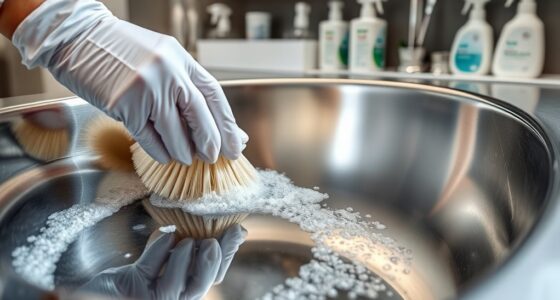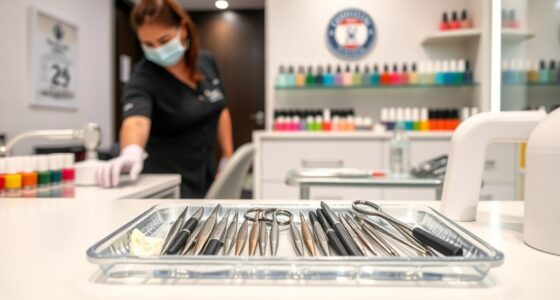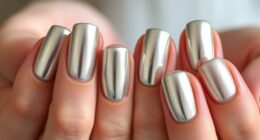Proper ventilation in your nail salon is vital for keeping harmful fumes, airborne particles, and chemicals under control. It helps remove pollutants, improve air quality, and protect your staff and clients from health issues like respiratory problems and skin irritation. By ensuring good airflow and regular maintenance, you create a safer, healthier environment. If you want to understand how to implement effective ventilation practices and stay compliant, there’s more to discover below.
Key Takeaways
- Proper ventilation removes harmful fumes and airborne particles, ensuring a safe environment for staff and clients.
- It prevents pollutant buildup, reducing health risks like respiratory issues and skin irritation.
- Effective systems include well-placed exhaust vents, filters, and local exhaust hoods for optimal fume capture.
- Regular maintenance and compliance with safety regulations are essential to sustain air quality.
- Enhancing ventilation with natural airflow and air purifiers improves air quality and minimizes long-term health hazards.
Understanding the Role of Ventilation in Nail Salons

Proper ventilation is essential in nail salons because it helps remove harmful fumes and airborne particles that can affect both workers and clients. Effective ventilation achieves this through proper air exchange, continuously replacing contaminated indoor air with fresh air from outside. This process promotes pollutant dispersion, preventing the buildup of chemicals and dust in the workspace. When air exchange is optimized, airborne pollutants are diluted and carried away, reducing health risks. Without adequate ventilation, these hazardous substances can linger, increasing exposure for everyone inside. Understanding how ventilation influences air movement allows you to implement systems that maximize pollutant dispersion. Proper ventilation also supports active listening and empathy, creating a safer and more comfortable environment for everyone. This keeps the environment safer, healthier, and more comfortable, ensuring that salon staff and clients aren’t exposed to dangerous fumes or particulates during treatments.
Common Airborne Hazards in Nail Care Environments

In nail salons, airborne hazards pose a significant health risk if not properly managed. You’re exposed to airborne chemicals like formaldehyde, toluene, and acetone from nail products, which can cause respiratory issues and skin irritation. Poor ventilation design allows these fumes to accumulate, increasing health risks for you and your coworkers. Without effective airflow, these hazardous particles linger in the air, making it harder to breathe and potentially leading to long-term health problems. Recognizing these common airborne hazards emphasizes the importance of proper ventilation systems that remove fumes efficiently. Implementing proper ventilation design ensures that airborne chemicals don’t reach dangerous levels, protecting your health and maintaining a safe salon environment. Proper airflow is essential for minimizing exposure to these airborne hazards, especially as advancements in AI safety measures continue to develop and improve overall safety standards.
Recognizing Signs of Poor Air Quality
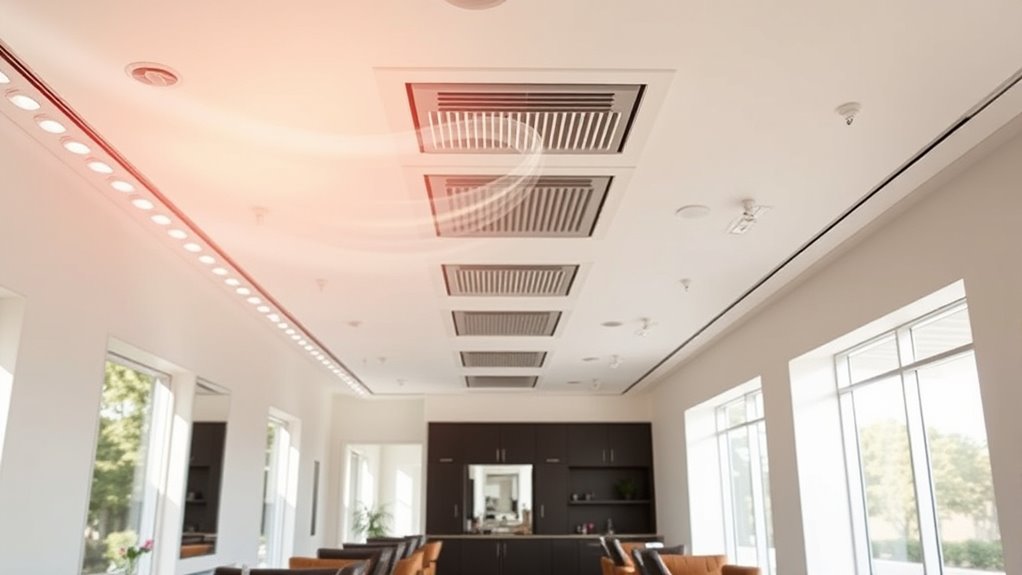
If you notice persistent, unusual odors in your salon, it could be a sign that the ventilation isn’t functioning properly. Keep an eye on your team and clients—if respiratory issues become more common, poor air quality might be the cause. Addressing these signs early can help ensure a safer, healthier environment for everyone. Additionally, monitoring for signs of poor air quality related to chemical fumes or insufficient airflow can prevent long-term health problems.
Unusual Odors Persistently Linger
Unusual odors that persist in a nail salon are clear signs that the air quality may be poor. If fresheners seem ineffective or odors linger despite regular use, it indicates inadequate ventilation. Relying solely on air freshener effectiveness doesn’t address the root problem; instead, consider odor absorption techniques like activated charcoal or HEPA filters that naturally trap airborne particles. Persistent smells from chemicals, acrylics, or disinfectants can build up, making the environment uncomfortable and potentially unsafe. If you notice these odors don’t dissipate quickly, it’s a sign that airflow isn’t sufficient. Proper ventilation helps remove pollutants and odors at their source, ensuring a healthier space. Additionally, high airflow rates are essential for maintaining good air quality in enclosed environments. Recognizing these signs early allows you to take corrective actions before poor air quality impacts your health or client satisfaction.
Respiratory Issues Increase
When air quality in your nail salon deteriorates, you may notice an increase in respiratory issues among staff and clients. Airborne toxins from nail products, dust, and fumes can irritate the respiratory system, leading to coughing, wheezing, or shortness of breath. You might observe clients or employees experiencing throat irritation or difficulty breathing after prolonged exposure. These signs indicate poor air quality and compromised respiratory health. If these symptoms become common, it’s a clear sign that your ventilation system isn’t effectively removing airborne toxins. Recognizing these signs early helps you take action to improve airflow, reduce airborne toxins, and protect everyone’s respiratory health. Proper ventilation not only minimizes health risks but also creates a safer, more comfortable environment for everyone in your salon. Implementing ventilation solutions can significantly improve indoor air quality and reduce health hazards associated with poor airflow.
Components of an Effective Ventilation System
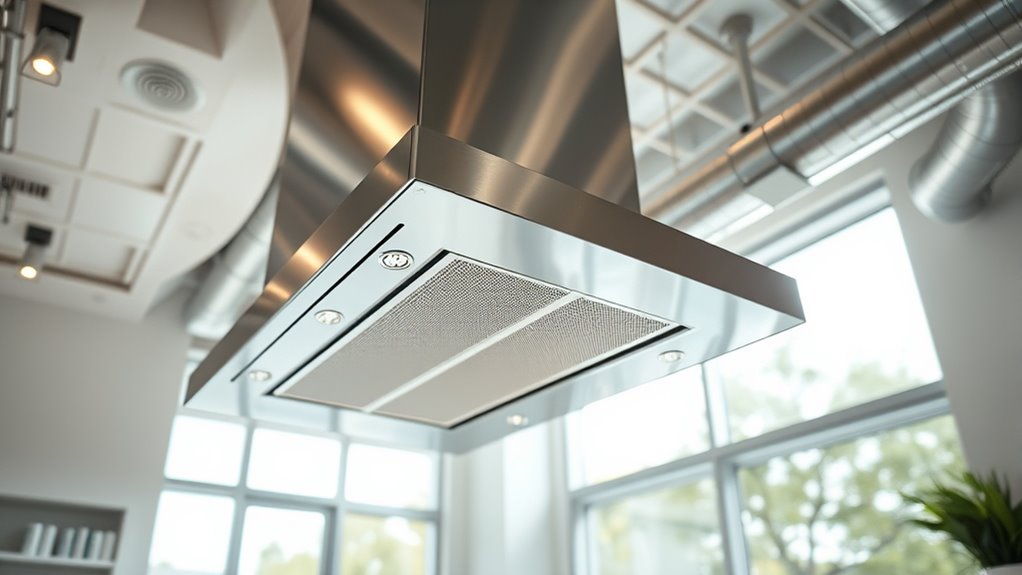
An effective ventilation system relies on airflow efficiency measures that guarantee contaminants are quickly removed from your workspace. You should also look for filtration technology features that trap airborne particles and improve air quality. These filtration systems are essential for capturing airborne particles and maintaining a clean environment. Together, these components create a safer, healthier environment for you and your clients.
Airflow Efficiency Measures
To guarantee effective ventilation in nail salons, you need to focus on airflow efficiency measures that optimize air movement and filtration. Improving airflow efficiency ensures fresh air circulates effectively while removing fumes and contaminants. Use properly placed exhaust vents and make sure they are powerful enough to handle the salon’s size. Position intake vents to promote smooth air circulation, preventing stagnant air pockets. Consider using adjustable ventilation systems so you can tailor airflow based on the salon’s needs. Regularly maintaining and inspecting vents and fans keeps airflow optimized and prevents blockages. Proper ventilation also involves selecting appropriate ventilation components that work together harmoniously. These measures help maximize ventilation efficiency, reducing airborne pollutants and ensuring a healthier environment for both clients and staff. Prioritizing airflow efficiency is essential for a safe, compliant, and comfortable nail salon.
Filtration Technology Features
Effective filtration technology is a key component of a ventilation system that keeps a nail salon safe and healthy. High-quality air filtration removes airborne particles, chemicals, and fumes, ensuring a cleaner environment. Look for systems equipped with advanced filters like HEPA or activated carbon filters, which excel at odor control and trapping fine particles. These filters improve air quality, reduce health risks, and keep unpleasant odors at bay. To maximize effectiveness, consider features such as:
- Multi-stage filtration for thorough air cleaning
- Activated carbon filters specifically for odor absorption
- Easy-to-maintain filter systems for consistent performance
- Incorporating Glycolic Acid Benefits in ventilation considerations can help in reducing residues and maintaining a healthier space.
Choosing the right filtration technology ensures your salon maintains a safe, odor-free atmosphere, protecting both clients and staff.
Best Practices for Maintaining Proper Airflow

Maintaining proper airflow in a nail salon is essential for ensuring a safe and healthy environment. To achieve this, focus on airflow enhancement by regularly inspecting and adjusting your ventilation system to ensure it functions efficiently. Keep vents and exhaust fans clean and unobstructed to promote consistent airflow. Schedule routine ventilation maintenance, including filter replacements and system checks, to prevent blockages and ensure optimal performance. Position fans and exhaust outlets strategically, directing airflow away from workstations and towards exhaust points. Educate staff on the importance of proper ventilation practices, encouraging them to report any airflow issues promptly. Incorporating effective strategies can further optimize your ventilation system and improve overall air quality. By prioritizing these best practices, you’ll enhance air quality, reduce airborne contaminants, and create a safer space for both clients and staff.
Legal Requirements and Industry Standards

Ensuring your nail salon complies with legal requirements and industry standards is critical for both safety and liability. By adhering to regulations, you protect your clients and staff from health risks associated with poor ventilation. Legal compliance involves following local and national codes related to air quality and safety. Industry standards often specify recommended ventilation rates and equipment standards to maintain a healthy environment. To meet these requirements, consider:
- Regular inspections and documentation of ventilation systems
- Staying updated with evolving regulations and standards
- Consulting with certified professionals for compliance assessments
- Implementing ventilation best practices to optimize air quality and reduce health hazards
Fulfilling these obligations not only safeguards health but also enhances your salon’s reputation and legal standing. Prioritizing compliance ensures you’re providing a safe, professional space for everyone.
Choosing the Right Ventilation Equipment
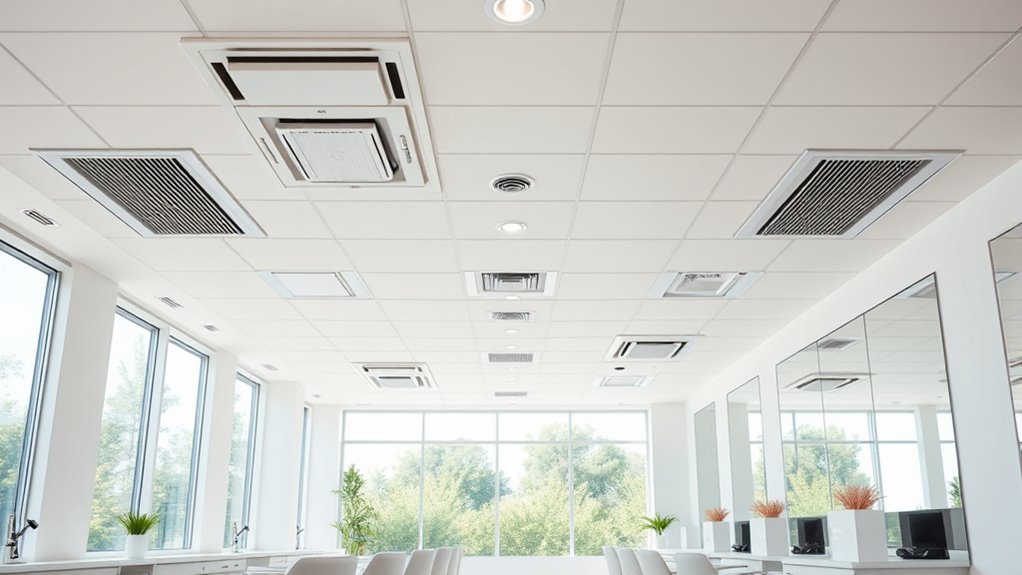
Choosing the right ventilation equipment is a key step in creating a safe and healthy nail salon environment. You need to take into account airflow patterns to ensure contaminants are effectively removed from the work area. Proper airflow helps direct fumes away from your clients and staff, reducing exposure. When selecting equipment, pay attention to placement; it should be positioned near nail stations and ventilated zones without obstructing movement. Adjustable exhaust hoods and local exhaust systems can improve airflow efficiency. Make sure the equipment is powerful enough to handle the salon’s size and volume of fumes. Regular maintenance and proper positioning are essential to maximize performance. Ultimately, choosing equipment with optimal airflow patterns and strategic placement keeps your salon safer and complies with health standards.
Impact of Ventilation on Worker and Client Health
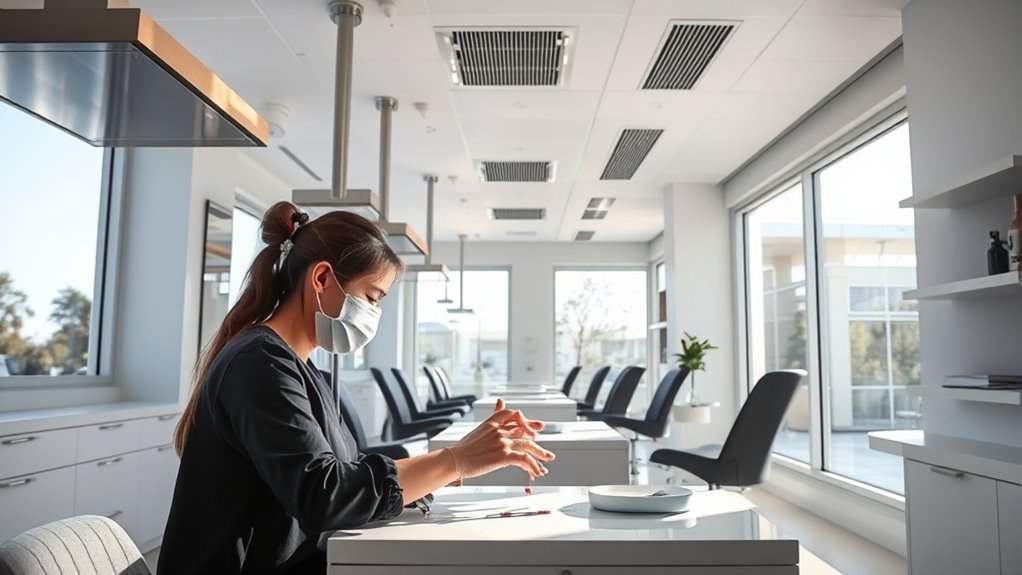
Proper ventilation plays a crucial role in safeguarding the health of both workers and clients in nail salons. Good air circulation ensures that airborne contaminants, like fumes from acrylics and chemicals, don’t accumulate. This directly improves air quality, reducing the risk of respiratory issues, headaches, and skin irritation. When your salon maintains proper ventilation, you create a safer environment that minimizes exposure to harmful vapors. Enhanced air circulation also helps disperse volatile organic compounds (VOCs), lowering health risks over time. To achieve this, consider:
- Regularly monitoring air quality levels
- Ensuring ventilation systems are properly maintained
- Incorporating high-efficiency exhaust fans
Prioritizing ventilation safeguards everyone’s health and promotes a more comfortable salon experience.
Tips for Improving Air Quality in Your Salon
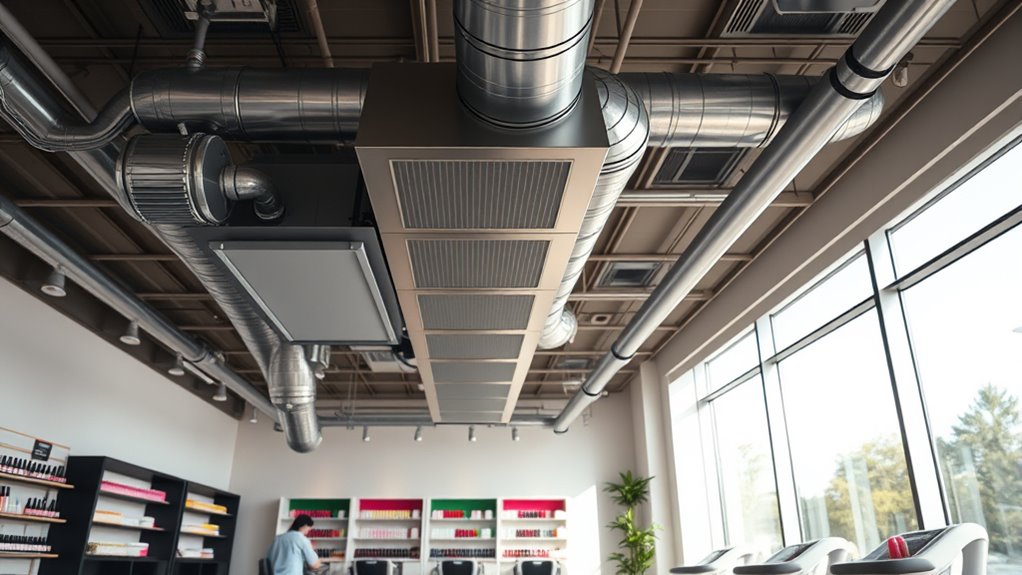
Improving the air quality in your salon starts with implementing practical strategies that reduce airborne contaminants and enhance ventilation design. First, ensure your ventilation system is properly maintained and equipped with high-quality filters that trap dust, fumes, and chemicals. Consider installing local exhaust hoods above workstations to capture vapors at the source. Keep windows open whenever possible to promote natural airflow, especially during peak hours. Use air purifiers with HEPA filters to further clean the air and reduce airborne particles. Regularly clean and replace HVAC filters to prevent buildup of contaminants. Educate staff on best practices, like proper product handling and minimizing fumes. These steps will considerably boost your salon’s air quality, creating a healthier environment for both clients and staff.
Frequently Asked Questions
How Often Should Ventilation Systems Be Inspected and Serviced?
You should inspect and service your ventilation system at least every six months to guarantee ideal airflow and air filter maintenance. Regular inspections help identify clogs or malfunctions early, preventing poor air quality. During servicing, clean or replace filters and check airflow levels. Consistent maintenance keeps your salon’s air fresh, protecting clients and staff from harmful fumes and ensuring compliance with health standards.
Are There Specific Ventilation Standards for Different Nail Salon Sizes?
While there aren’t strict, one-size-fits-all standards, your salon’s layout and ventilation design should guide your approach. Larger salons may need more robust systems to guarantee air quality, while smaller spaces can often rely on simpler solutions. It’s wise to consult local regulations and industry best practices, tailoring your ventilation setup to your salon’s size. Properly designed ventilation fosters a healthier environment, keeping both clients and staff comfortable and safe.
Can Portable Air Purifiers Replace Permanent Ventilation Systems?
Portable air purifiers can’t fully replace permanent ventilation systems because of their air purifier limitations, such as limited coverage and lower effectiveness in removing fumes and airborne contaminants. A cost effectiveness analysis shows that while they’re cheaper upfront, they may not provide adequate long-term air quality. To guarantee safety, you should consider integrated ventilation solutions tailored to your salon’s size rather than relying solely on portable air purifiers.
How Does Ventilation Impact the Longevity of Salon Equipment?
Think of your salon equipment as a delicate dance partner—poor ventilation leads to premature wear. When you guarantee good air quality, it keeps dust, fumes, and moisture from settling on machines, extending their lifespan. Proper ventilation reduces corrosion and buildup, allowing your equipment to perform better and last longer. In short, maintaining excellent air quality isn’t just about health; it’s a smart move to protect your investment.
What Training Is Required for Staff to Properly Operate Ventilation Systems?
You need to guarantee staff complete thorough staff training on ventilation maintenance to operate systems safely and effectively. This training covers understanding system components, proper usage, and troubleshooting. By prioritizing staff education, you help maintain ideal air quality, prevent system malfunctions, and ensure a safe environment for both clients and employees. Continuous updates and refresher courses are also essential to keep everyone informed about best practices and new ventilation technologies.
Conclusion
Think of your nail salon as a gust of fresh air in a busy city. Proper ventilation clears out airborne hazards like dust and fumes, creating a safer, healthier space for both workers and clients. When you prioritize good airflow, you’re tending to a garden where health blossoms. Keep the air flowing steadily, and watch your salon thrive—because fresh air isn’t just a luxury, it’s the foundation of a safe, vibrant environment.


